Art History
Hans Holbein’s Masterful ‘Ambassadors’ Is Full of Extraordinary Riddles. Here Are 3 Facts to Help You Make Sense of Them
The painting has been the subject of boisterous debate for decades.
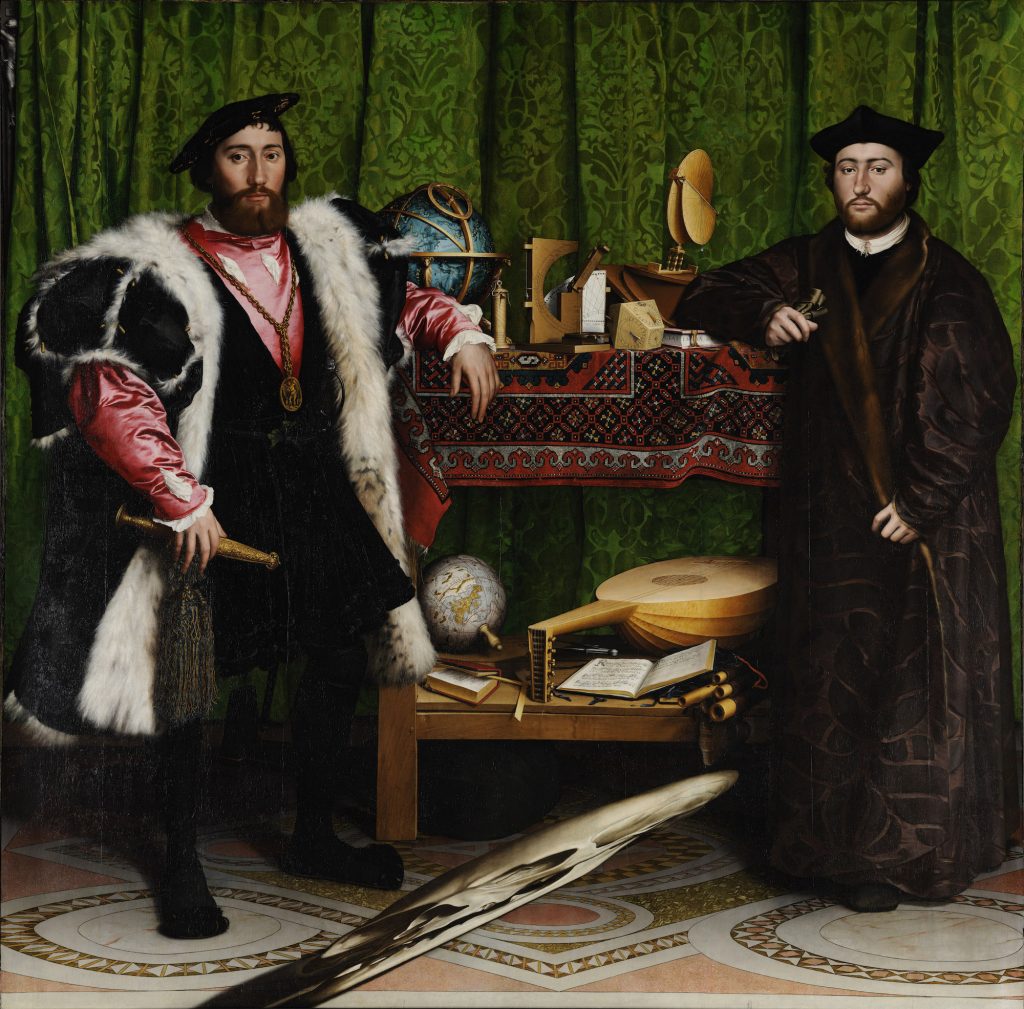
The painting has been the subject of boisterous debate for decades.

Katie White

Hans Holbein the Younger’s The Ambassadors (1533) is a painting that simply begs to be decoded. The highly unusual Renaissance double portrait depicts two luxuriously clad Frenchmen standing on either side of a shelf cluttered with globes, astronomical devices, a lute, a hymnal, and various potentially significant objects. Oh, and lest we forget to mention the painting’s most famous aspect: a massive anamorphic skull occupies the bottom of the painting, hovering between the two men.
The presence of this skull, which unless viewed from a specific angle looks more like a gray smear, appears without much explanation or precedence (actually, this is the only known instance of Holbein employing anamorphosis in his paintings). The Ambassadors, we might say then, is purposefully oblique.
In approaching the analysis of the painting, the best place to start might be with what we know most confidently. The two figures are almost certainly the French ambassador, Jean de Dinteville (on the left), who is believed to have commissioned the painting, and his friend Georges de Selve, the Bishop of Lavaur (right), who had come to visit Dinteville while he was dispatched to London. The painting commemorates their ages: Dinteville is 29, as marked on his dagger; and Selvee, 25, as written on the book next to him.
The German-born Holbein painted the portrait while living in England in what was a particularly tumultuous time for the country. Dinteville commissioned The Ambasadors the year of Elizabeth I’s birth, soon after the controversial marriage of Henry VIII and Anne Boyelyn. Dinteville is believed to have attended the wedding ceremony, and it is possible that he is shown in his wedding attire. Sooner after completing this double portrait, Holbein was named court painter to Henry VIII.
Almost 500 years on, Hans Holbein the Younger is again on the minds of art lovers, with New York’s Morgan Library and Museum currently hosting “Capturing Character,” the largest showcase of Holbein’s work in the United States in decades. The Ambassadors hasn’t made the journey over from the National Gallery in London, where it has been in the collection since 1890. But nevertheless, we decided we would turn our eyes to this riddle of a painting.
Here are three facts that help us grapple with this enigmatic masterpiece.
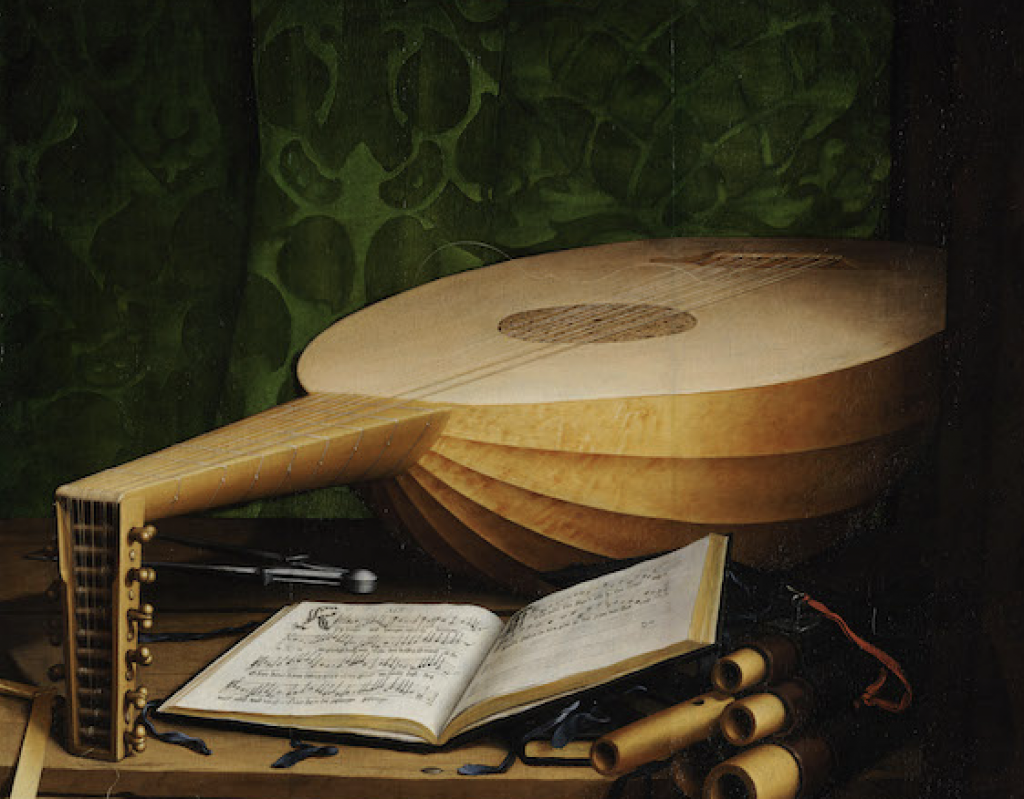
Detail of Holbein’s The Ambassadors (1533).
Considering that this is, after all, a portrait called The Ambassadors, we might stop and ask ourselves what exactly Dinteville was up to while living in England. He wasn’t having a grand old time. “I am the most melancholy, weary, and wearisome ambassador that even was seen,” De Dinteville wrote in a letter back to France.
By its nature, Dinteville’s position entailed relaying the gossip, intrigue, and political maneuverings of the English court back to his counterparts in France; given the upheaval of the age, there was a distressing amount for Dinteville to keep abreast of. In the same year the painting was completed, King Henry VIII would divorce his first wife, Catherine, of Aragon, and marry Anne Boleyn. Catherine, who had strong ties to the Catholic Church, opposed the annulment, and the Church proved unwilling to grant a divorce.
To follow through on his marriage to Boleyn, Henry VIII broke with the Church, setting in motion the Reformation in England, an era of bloodshed and strife. Dinteville’s own allegiance is made clear by the medallion of the Catholic order of St. Michel around his neck, while Selve is shown in his clerical vestments, standing as a representative of the Church itself.
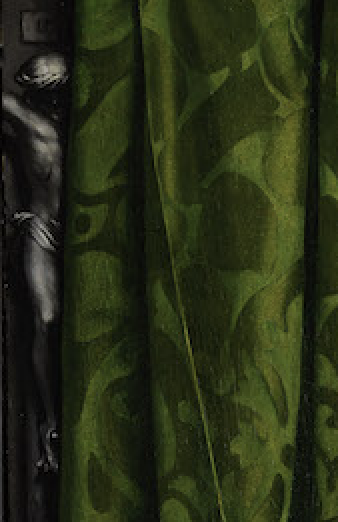
Detail of Holbein’s The Ambassadors (1533).
Holbein hints at this religious tension throughout the composition. The lute on the shelf is pictured with a broken string, a traditional symbol of discord. Holbein has rendered the hymnal with such care that we can read its writings by Martin Luther, the leader of the Protestant Reformation.
Lastly, the floor upon which the two men stand is a reproduction of flooring at Westminster Abbey, which was in this era a Catholic church; the floor design is that of Cosmatesque pattern, which was meant to embody the macrocosm of the universe and its order. In the most direct reference, behind the green curtain on the left, Holbein has placed a crucifix, of which we can see just a glimpse.
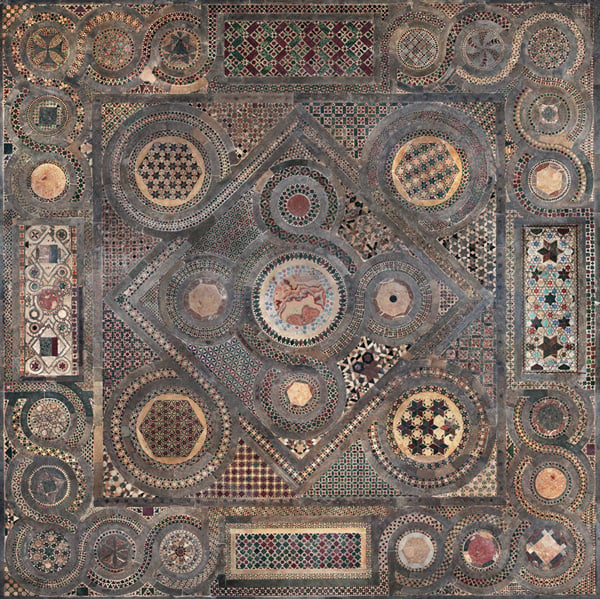
Cosmati pavement at Westminster Abbey. Courtesy of Westminster Abbey.
It’s worth noting that Holbein started his career as a painter of religious subjects. His father, Hans Holbein the Elder, was famed for his vividly colorful religious works. Holbein, then, would have been sensitive to the symbolism of the Church, and its rupture with England.
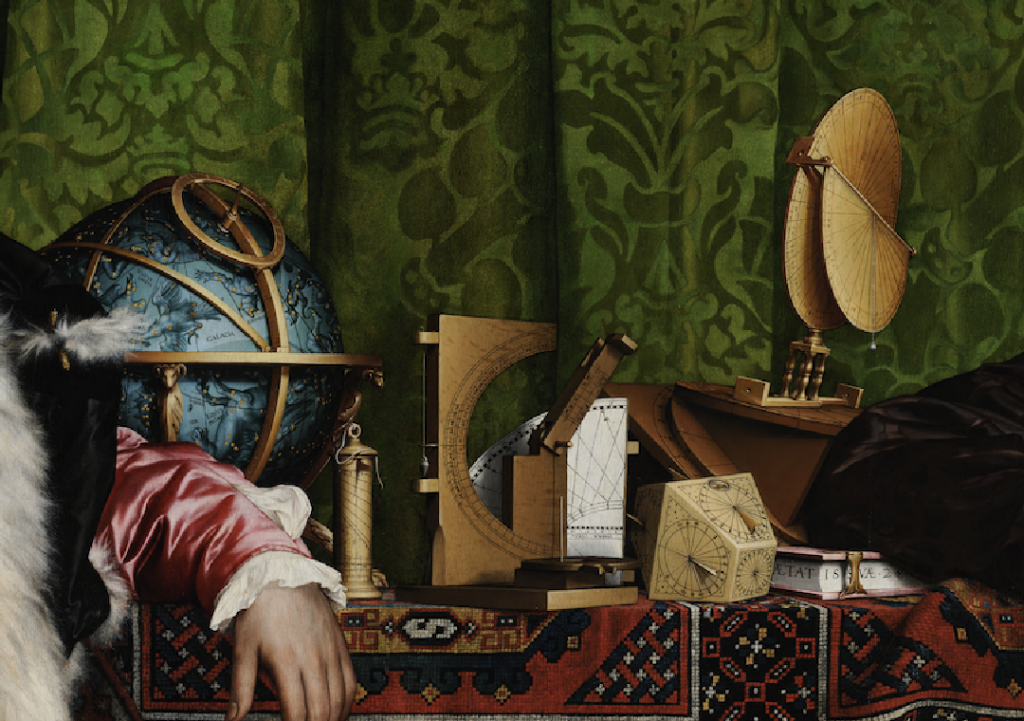
Detail of Holbein’s The Ambassadors (1533).
The Cosmatesque pavement is just one of many allusions to mapping and celestial order in the painting. On the top level of the shelf, in the center of the canvas, we see a variety of scientific instruments used for observing celestial movements including a shepherd’s dial, a quadrant, a torquetum, and a polyhedral sundial.
The shelf below can be read as holding emblems of the living world, including the lute, the hymnal, and books about arithmetic. Each shelf holds a globe: the upper globe maps the heavens and stars, the lower represents the earth’s landmasses (at least, a 1530s version of it). Meanwhile, directly below both shelves, we see the skull on the floor, a memento mori, or reminder of death.
In this way, the painting can be read in three bands from top, middle, and bottom as the heavens, earthly life, and the inevitability of death. The painting can also be read as divided from left to right, with Dinteville on the left with his scabbard and ornate clothing representing the active life, and Selve, in his clerical vestments and prayer book, representing the contemplative life.
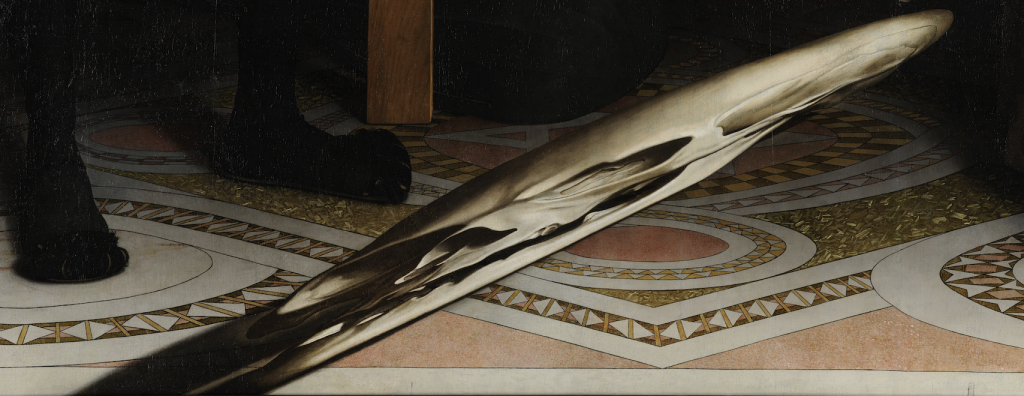
Detail of Holbein’s The Ambassadors (1533).
The skull is so remarked upon is actually quite difficult to make out, except for when viewers are positioned to the right of the painting. Many believe that Jean de Dinteville commissioned it with the intention of hanging it on a wall with an entrance to its right, meaning that viewers would have been first confronted by the skull, only to have it dissolve as they moved to the front of the painting.
Sixteenth-century paintings rarely included anamorphic objects, and when they did, it was to create a comic trickery or visual pun, not as a serious artistic device, as seen here. In one sense, we can read the skull as showcasing Holbein’s mastery of perspective. This talent is often underscored by the highly foreshortened depiction of the lute; lutes were traditionally the object with which artists learned the tenets of perspective. Here, Holbein shows the instrument in the most extreme of these perspectives, showing off his virtuosity. Similarly, the floor is painted in perfect linear perspective.
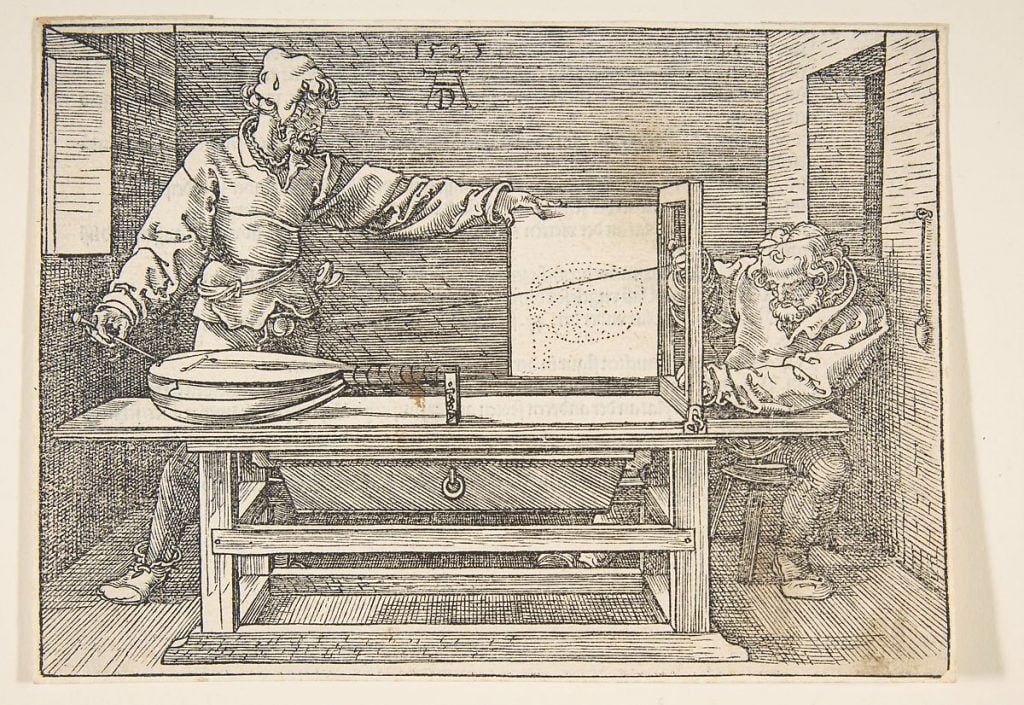
Albrecht Dürer, The Draughtsman of the Lute n.d. Collection of the Metropolitan Museum of Art.
While these devices could certainly be Holbein showcasing his talents, perhaps in the hopes of earning more commissions, in the essay “The ‘Unusual Character’ of Holbein’s Ambassadors,” philosopher and scholar Hagi Kenaan supposes that Holbein’s emphasis on what he allows viewers to see and not to see is the key to understanding the work.
Kenaan notes that the green curtain behind the figures is another anomaly, similar in function to the skull. The curtain doesn’t serve the typical purpose of embellishing a blank wall, but rather shrouds another scene.
“We may observe that what makes this curtain singular in character is its theatricality, or, better yet, its implied suggestion of a hidden reality behind the scenes,” Kenaan writes. “It is what divides the original space of the Ambassadors into the visible and the invisible. Moreover, as we consider the partially revealed crucifix behind the upper left corner of the curtain, the possibility of a reality existing behind the curtain is underscored. That is, instead of defining the interior bounds of the scene establishing a clear limit for the viewer’s gaze, the curtain suggests the presence of a depth beyond itself.”
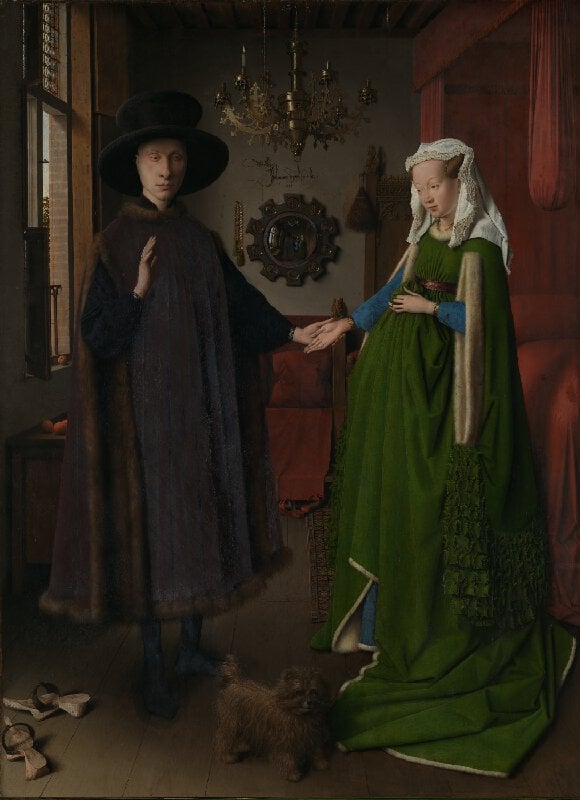
Jan van Eyck, Portrait of Giovanni Arnolfini and his Wife (1434). Courtesy of the National Gallery.
Kenaan rightly points out something so obvious to be missed: that a portrait of two men, with no ostensible political connection, was highly unlikely in the Renaissance. Here Kenaan novelly connects The Ambassadors to the most famous precedent for double portraits: Van Eyck’s Arnolfini Portrait.
“In addition to its arrangement of sitters, skull, and crucifix, this portrait tradition also provides a pictorial source for The Ambassadors‘ enigmatic concealment of the image of the skull,” Kenaan writes.
“In considering certain German couple portraits from the second half of the 15th century, we see… that they are executed as double-sided pictures showing, on the obverses full-length portraits of young couples and on the reverses images of their decaying corpses. In other words, these are portraits whose preoccupation with mortality does not present itself in the painting’s immediate pictorial scheme, whose hidden presence of death can only be uncovered (as In the Ambassadors) by the viewer’s ability to look at things from their ‘other side.’”